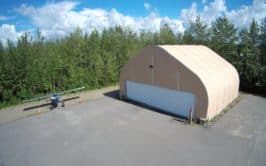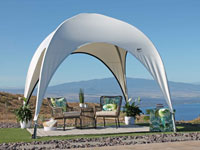Because of the ongoing spread of coronavirus, back-to-school preparations are looking a little different this year for school districts. School buildings have long been designed as large gathering spaces meant to encourage intermingling and group learning. This layout isn’t conducive to stopping the spread of a highly infectious virus. Retrofitting school buildings to accommodate social distancing and reduce the possibility for virus transmission needs to be at the forefront of everyone’s mind before deciding to reopen schools in the fall.
Districts need to take into consideration the way the virus spreads, how to properly enforce social distancing, and what “problem” areas of the school building need to be fixed or altered. Solutions include limiting the number of students per classroom, designating entrances and exits. Also, adding temporary outdoor structures for classrooms and offices could help reopen schools safely while we battle COVID-19.
How Coronavirus Spreads
The coronavirus that causes COVID-19 can be spread from person to person through respiratory droplets. Activities such as coughing, sneezing, or even talking can spread the virus to anyone within six feet, and linger in the air for up to three hours, which is why social distancing and face coverings are so important to slowing the spread and preventing infection.
The virus can also live on surfaces such as plastic or stainless steel for two to three days, so frequent and thorough disinfecting of commonly used surfaces is highly encouraged.
Enclosed environments with little airflow have also been found to be the best environments for the virus to spread.
What Is Social Distancing?
Social distancing should be a mandatory practice in schools that are reopening. In order to practice social distancing, students, teachers, and staff need to increase the amount of space between each individuals.
The typical crowded hallways and large classrooms would be a quick breeding ground for the virus — so spaced out desks, smaller classrooms, and less people walking through or spending time in common areas are a few possible solutions.
The Decision to Reopen Schools
The argument for keeping schools closed while the pandemic controversial. Cautiously reopening schools with a special regulations is a big topic.
School closures will undoubtedly have a negative impact on the educational, social, and emotional well-being of children. Opening schools normally could have devastating effects on students’ physical health and increase the spread of the virus throughout the school’s community.
The decision to reopen isn’t an easy one. Schools that are reopening need to follow federal safety guidelines and do all they can to prevent the spread of the virus and protect students and employees.
The Centers for Disease Control and Prevention (CDC) published a decision tree in May to help school districts decide if they’re ready for the responsibility of reopening.
Questions include:
- Is the school ready to protect children and employees at higher risk for severe illness?
- Are you able to screen students and employees upon arrival for symptoms and history of exposure?
- Is ongoing monitoring in place?
The answers to all of these questions moving through the decision tree should be a resounding “yes.” If those deciding come to a “no,” the school district should not reopen yet until it can follow these guidelines and be adequately prepared.
Issues Faced by “Normal” School
Schools as we know them currently have a lot of issues that could potentially increase the spread of the coronavirus and create a dangerous environment for students, teachers, and staff. Things such as crowded hallways in between periods, full classrooms, bottle-necked doorways, and the use of common gathering spaces such as teachers lounges, cafeterias, and gymnasiums are all elements that schools need to alter in order to keep everyone safe from the coronavirus.
Some solutions to make schools safer and better equipped to slow the spread of the virus include:
- One-way entrances and exits
- Different “shifts” of students coming to school
- Keeping a set of students in one classroom to avoid transference
- Adding hand washing and sanitizing stations
- Automatic soap disposal and air dryers in bathrooms
- Limiting the number of people in small places such as bathrooms, offices, and conference rooms
- Eliminating shared water fountains
- Adding protective plexiglass shields to high-traffic areas such as the front office
- Getting rid of buffet-style cafeteria lunches
- Improving old HVAC systems for better airflow and equipping them with proper filtration systems
Solutions that will help reopen schools are modular classrooms, or retrofitting unused rooms, to make more space and avoid overcrowding. Outdoor classrooms, offices, and other traditionally indoor areas of the school would help eliminate transmission of the virus by increasing space and airflow. Temporary, portable shade structures are a simple solution that can create these outdoor spaces easily.
How Temporary Shade Structures Can Help Reopen Schools
Sanitization & Check-In Pre-Entrance
Creating a check-in station outside the entrance of your school is a wise idea. Fabric structures provide shade while students and staff sanitize before entering, and pick up clean masks.
Depending on the size of your school, you could even use this area to take temperatures. Have students and staff sign in to make contact tracing easier if someone tests positive for the virus.
Front Desk
A temporary shade structure at the front of the building, either separate or a part of the sanitation station, could be home to the front desk.
With the right tools, front desk administrative personnel could conduct their jobs and eliminate the need for indoor office space.
Classrooms
Outdoor classrooms could have the biggest impact on reopening schools. This would allow in-person teaching while maintaining social distance and providing a fresh-air learning environment.
Increased access to nature has been proven to boost productivity and improve your mood, which is a bonus in addition to lowering virus transmission.
Recess
For schools with younger students, portable fabric structures could provide helpful organization as well as much needed shade for recess or outdoor physical education.
Multiple shade structures in different areas of the playground could be a different “activity zone” for a limited number of individuals during recess or P.E., without sharing equipment.
WeatherPort Shade Structures
WeatherPort®, a brand from Alaska Structures creates custom-designed tensioned fabric structures that are perfect for outdoor school accommodations.
Our portable shade structures are durable against all types of weather, blocking harmful UV rays as well as protecting against sudden downpours. They are also built with the highest-quality materials and simple to set up quickly and rearrange in different areas. You can even customize your shade structure with your school’s logo or colors to create a more welcoming back-to-school environment.
WeatherPort® is a brand of high-quality fabric buildings from Alaska Structures®. If you are interested in learning more about our fabric buildings and remote camp systems please contact us by calling +1-907-344-1565 or completing our online form to request a consultation.

















































































Leave a Reply